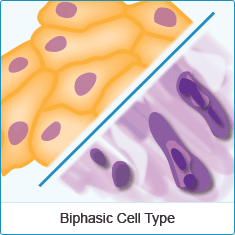 Biphasic mesothelioma is a mixed type of mesothelioma, which has both epithelioid and sarcomatoid type cells present. The cells usually arrange in separate groups within a biphasic tumor, which is why biopsies are typically taken from different parts of the tumor. This type of mesothelioma makes up approximately 30% of all cases.
Biphasic mesothelioma is a mixed type of mesothelioma, which has both epithelioid and sarcomatoid type cells present. The cells usually arrange in separate groups within a biphasic tumor, which is why biopsies are typically taken from different parts of the tumor. This type of mesothelioma makes up approximately 30% of all cases.
Biphasic mesothelioma varies depending on the ratio of epithelioid to sarcomatoid cells. The behavior of this type of mesothelioma is related to which cells make up the majority of the tumors. If the tumor has more epithelioid cells, the tumor is likely to grow faster in a localized area. If the tumor has a majority of sarcomatoid cells, the cancer itself is likely to spread more quickly through the blood and lymph system.
Prognoses for biphasic mesothelioma patients tend to vary because of the nature of the mixed-cell tumor. Some studies show biphasic patients have a better survival rate than epithelioid patients and vice versa. Prognosis is usually dependent on which cell type makes up the majority of the tumor.


Malignant biphasic mesothelioma is the second most common cell type of mesothelioma. Patients with this form of mesothelioma will have varying life expectancy rates because prognosis will depend on the ratio of epithelial and sarcomatoid cells. Learning about biphasic mesothelioma and understanding its characteristics, how it is diagnosed, and how this type affects treatment can help you make informed decisions with your doctor.

Approximately 20 to 35 percent of all malignant mesothelioma cases are classified as biphasic mesothelioma. This cell type is more common among pleural mesothelioma patients than any other type of mesothelioma. It is important to determine if both epithelial and sarcomatoid cells are present because this information may have an impact on your prognosis.
Characteristics of Biphasic Mesothelioma

EPITHELIOID
Epithelioid mesothelioma is comprised of round, cube-like cells that have long and slender microvilli, which are small hair-like protrusions in the cell membrane.
BIPHASIC
Biphasic mesothelioma is often called the "mixed" cell type because it is made up of cells from both of the other two mesothelioma cell types.
SARCOMATOID
Sarcomatoid mesothelioma is made up of spindle-shaped cells arranged in a disorganized fashion.
In biphasic mesothelioma, epithelioid cells and sarcomatoid cells can exist in close proximity or, more frequently, within distinctly separate areas of a tumor. These cell types are important to detect because some clinical trials and treatments can be targeted at specific cells. The characteristics of your cell type do not affect your symptoms and they may only affect your prognosis by a few months. The diagnostic process can be harder for biphasic mesothelioma since epithelioid and sarcomatoid cells must both be detected.
How Biphasic Mesothelioma is Diagnosed
Biphasic mesothelioma can be difficult to detect and diagnose because typical biopsies usually take a small sample of tissue and epithelioid and sarcomatoid cells can actually exist in different areas of the tumor. A more accurate diagnosis of biphasic mesothelioma is more likely after evaluating a larger sample from several parts of the tumor during a surgical biopsy.
In order to diagnose biphasic mesothelioma, other types of cancer that can display biphasic characteristics such as synovial sarcomas and carcinosarcomas must be ruled out. Techniques such as immunohistochemistry, which identifies and labels certain proteins in cells, can be used to distinguish biphasic mesothelioma from these other diseases.
A recent study published in the Journal of Thoracic Oncology found that biphasic mesothelioma can be misdiagnosed with a biopsy and more accurately diagnosed following surgery. A total of 83 patients in the study were confirmed to have biphasic pleural mesothelioma after undergoing an extensive surgical procedure called an extrapleural pneumonectomy. However, only 26 percent of those patients had been originally diagnosed with the biphasic subtype. The initial diagnostic methods included thoracoscopy, thoracotomy, computerized tomography or other biopsymethods. Obtaining an accurate cell type diagnosis is important since it could slightly affect treatment options and prognosis.
How Biphasic Cells Affect Treatment and Prognosis
Treatment for mesothelioma generally depends more on the stage and location of the tumor rather than the cell type involved. Because biphasic mesothelioma carries a slightly poorer prognosis than epithelioid mesothelioma, patients with the biphasic cell type may not be considered for as aggressive of a treatment plan as epithelioid patients. However, treatment is not completely based on cell type, and most patients undergo one or more of the three most common therapies for mesothelioma, including:
The prognosis for patients with biphasic mesothelioma will vary depending on the mix and ratio of epithelial and sarcomatoid cells that are present in each case. Because sarcomatoid cells are less responsive to treatment than epithelial cells, biphasic mesothelioma patients with lower levels of sarcomatoid cells tend to receive better results from treatment. Thus, the more epithelial cells you have in a biphasic mix, the better your prognosis may be. How much better may amount to only a few months depending on the case.
Want to Learn More About Your Cell Type?
We provide a free informational packet that describes every detail of your case. To receive this packet in the mail, fill out the form on this page or request one after speaking with one of our Patient and Family Advocates at (800) 615-2270.
View Article Sources


0 comments:
Post a Comment